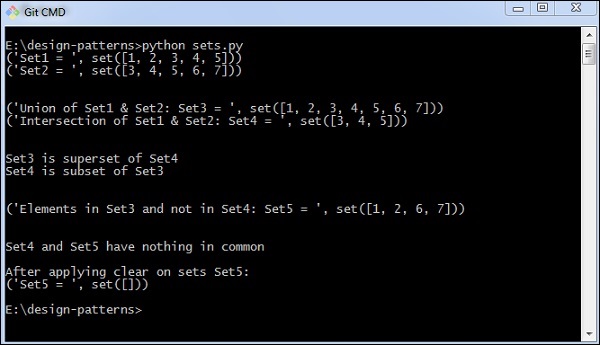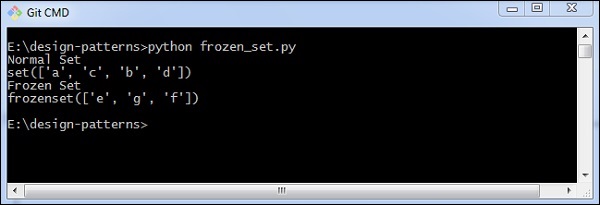Python Design Patterns – Sets
A set can be defined as unordered collection that is iterable, mutable and there is no inclusion of duplicate elements in it. In Python, set class is a notation of mathematical set. The main advantage of using a set is that it includes highly optimized method for checking specific element.
Python includes a separate category called frozen sets. These sets are immutable objects that only support methods and operators that produce a required result.
How to implement sets?
The following program helps in the implementation of sets −
# Set in Python # Creating two sets set1 = set() set2 = set() # Adding elements to set1 for i in range(1, 6): set1.add(i) # Adding elements to set2 for i in range(3, 8): set2.add(i) print("Set1 = ", set1) print("Set2 = ", set2) print("\n") # Union of set1 and set2 set3 = set1 | set2# set1.union(set2) print("Union of Set1 & Set2: Set3 = ", set3) # Intersection of set1 and set2 set4 = set1 & set2# set1.intersection(set2) print("Intersection of Set1 & Set2: Set4 = ", set4) print("\n") # Checking relation between set3 and set4 if set3 > set4: # set3.issuperset(set4) print("Set3 is superset of Set4") elif set3 < set4: # set3.issubset(set4) print("Set3 is subset of Set4") else : # set3 == set4 print("Set3 is same as Set4") # displaying relation between set4 and set3 if set4 < set3: # set4.issubset(set3) print("Set4 is subset of Set3") print("\n") # difference between set3 and set4 set5 = set3 - set4 print("Elements in Set3 and not in Set4: Set5 = ", set5) print("\n") # checkv if set4 and set5 are disjoint sets if set4.isdisjoint(set5): print("Set4 and Set5 have nothing in common\n") # Removing all the values of set5 set5.clear() print("After applying clear on sets Set5: ") print("Set5 = ", set5)
Output
The above program generates the following output −

The frozen set can be demonstrated using the following program −
normal_set = set(["a", "b","c"]) # Adding an element to normal set is fine normal_set.add("d") print("Normal Set") print(normal_set) # A frozen set frozen_set = frozenset(["e", "f", "g"]) print("Frozen Set") print(frozen_set)
Output
The above program generates the following output −

